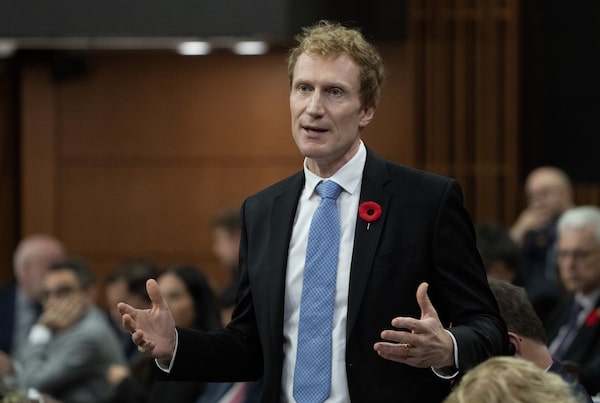
Immigration, Refugees and Citizenship Minister Marc Miller rises during Question Period, in Ottawa on Oct. 31. New targets tabled in Parliament show the government plans to level out the number of new permanent residents to Canada in 2026, forecasting an end to record-breaking year-over-year immigration.Adrian Wyld/The Canadian Press
Food Banks Canada reports that 26.6 per cent of food bank users are people who immigrated in the last decade. That’s more than double the figure in 2019.
It’s one more statistic that illustrates how the Liberals took our good immigration system and broke it.
The main mechanism for deciding who gets to join the Canadian family is supposed to be the points system. When it comes to economic immigrants – and the aim of immigration is always billed as economic returns to Canada, especially by the current government – those offering the greatest benefits to this country are supposed to go to the front of the line.
Under a proper application of the points system, the vast majority of new arrivals would be more educated, more skilled and better paid than native-born Canadians.
There aren’t many doctors, engineers or skilled tradespeople in need of a free hamper of canned goods. It’s a different story for people working insecure jobs, earning minimum wage (or less) and living cheque to cheque.
Under the Liberals’ quiet reworking of the immigration system, the latter group’s numbers have boomed.
Last week, the Trudeau government made an abrupt U-turn on the carbon tax, while claiming to be doing nothing of the sort. This week, it promised to stick to the path of vertiginously rising immigration until at least 2026 – while claiming that it was actually taking a step back and “stabilizing” immigration levels.
If the decision matrix had been good economic policy, the government would have U-turned on immigration, while holding firm on carbon pricing.
However, the Liberals eight years ago hit on immigration as a sweet spot on the political Venn diagram, where two otherwise hostile interest groups intersect. Young, progressive voters increasingly see the world through a lens of race and privilege, with higher immigration as a matter of moral principle, and limits as presumptively racist. And business always claims to be facing labour shortages, especially for low-paying jobs; it would prefer to not have to address them through higher wages.
As a result, the Liberals haven’t just raised permanent immigration, with the number of new Canadians minted each year nearly doubling since 2015. The government has also fostered a related, and even bigger, temporary foreign worker stream.
In 2021, Canada had 1.3 million temporary foreign residents. There are now 2.2 million – officially. Unofficially, there may be a million more.
Last July, I wrote about the 10,000 job postings in the TFW job bank, most for low-wage jobs. As of early Thursday afternoon, the database had 12,253 job postings. The most recent were for two full-time “sandwich artists” in Tisdale, Sask., at $14 to $15 an hour, and two full-time cooks at a pizza restaurant in Mississauga, Ont, at $17 to $18 an hour.
The database is brimming with jobs paying well below the Canadian average. These are precisely the kinds of jobs the immigration system should not be used to fill. And yet, over eight years of Liberal government, filling such jobs has become one of the immigration system’s main uses.
You should question the economic logic.
A bigger Canadian population means a bigger gross domestic product; that’s the talking point Immigration Minister Marc Miller repeated time and again this week.
Who cares? What matters is economic output relative to the size of our population. India has a bigger GDP than Canada, but Canada’s GDP per person is much higher. And that’s the only real yardstick.
The logical goal for Canadian immigration policy, which benefits all Canadians, is leveraging it to raise GDP per capita. That means aiming for an economic pie that’s grows faster than the number of forks. That can happen when new arrivals are more skilled than the average Canadian, and produce and earn more than average.
But when a large share of new arrivals are recruited precisely because they’re low-wage workers, the census of forks will tend to grow faster than the pie. That spells lower growth in average living standards, not to mention higher inequality.
The Liberals need to scale back permanent immigration. But what they really need to cut are the number of low-skill temporary foreign workers, and the exploding number of visa students enrolling in low-quality college and university programs that are selling not education, but the legal right to come to Canada, to work in Canada and to reach for the ultimate prize: Canadian citizenship.
Business will scream. Universities and colleges will scream. Left-wing activists will scream. Let them. The majority will nod in quiet agreement. And in the long run, Canada’s economy will be better off.